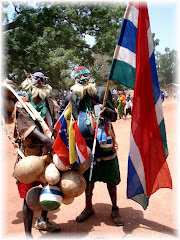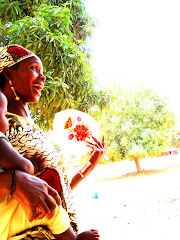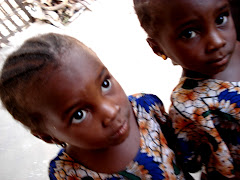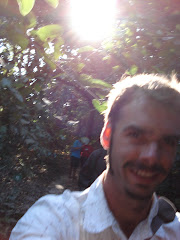
With the arrival of the rains The Gambia has come alive. Everywhere I look I see shades of green and layers of life. Some of the growth is chaotic and wild; the natural world coming out of its droughted stupor. Elsewhere neat and ordered rows of millet, sorghum, and groundnuts grid my surroundings. After months of living amongst the shades of yellow, brown, and grey I suddenly feel like I am camping on a golf course with its neatly trimmed greens, dramatic water holes, and occasional sand traps. It is like that surreal morning in New Mexico or anywhere following the first snow fall: I know this place by heart yet somehow now it is changed. The shapes are sort of as I remember but the textures and hues of the world are all brand new.
The Gambia is a beautiful place. I first wrote these words in my journal almost ten months ago when I arrived a virgin to the West African sub-tropics. Now I have witnessed the transformations that such a place will go through and I am amazed. My own disposition too has changed; the feelings of life awakening, of a giddy lightness. Maybe I was suffering from a little seasonal depression but now I can feel a weight lifted and a hope renewing. All my plans, helpful gardening hints, and widely-heralded seedlings wouldn’t be worth a hill of beans to these people if it simply didn’t rain this year. But it is raining. I was a little worried for a while but now I am reassured. When I came here in October, it was almost harvest season-- still lush and vibrant. Since then I have watched farm soil turn to alluvial dust, seen trees turn bare, pitied the livestock as their skeletons became visible beneath thin hides. Now tall grasses are thriving, crops are consuming the landscape, and animals are growing fat.
the livestock as their skeletons became visible beneath thin hides. Now tall grasses are thriving, crops are consuming the landscape, and animals are growing fat.
 the livestock as their skeletons became visible beneath thin hides. Now tall grasses are thriving, crops are consuming the landscape, and animals are growing fat.
the livestock as their skeletons became visible beneath thin hides. Now tall grasses are thriving, crops are consuming the landscape, and animals are growing fat. And bush fruit, such as this tabo fruit, are coming ripe.
So many people are planting so many things. Hardly a patch of usable space within walking distance of my village is left unturned. Millet, rice, squash, watermelon, corn, bitter tomatoes, eggplant, sorghum, findi, and groundnuts. Teams of bulls and drowsy donkeys, men and boys with arched backs in the fields, women and girls slogging in the rice paddies. Farming implements amaze me and I feel like I am back doing archaeology in the Southwest. Broken down but still usable seeders and weeders dragged behind scrawny beasts. Digging sticks. Hewn branches with locally smithed iron tips. Handhoes and machetes. Chunwars, golos, sombes, and jalos. Seeds transported to the fields in last year’s calabash gourds.
Junkong, Landing, Galel, and I have most of our planting finished. We have about one hectare (100x100m) of groundnuts planted in the field that I cleared last month. You might recall from my last blog entry that I had convinced Landing to leave the camelfoot trees (Piliostigma tongii) as recommended in agroforestry resources. When I returned home from Kombo though, I was disappointed to find that he had changed his mind and cut them all down. I asked him about it and he said that Baa Cheike had told him to do it. The old man has been farming here since before my father was born (a million miles away) and he has never heard of anyone leaving the barke (Pulaar) tree to grow among crops. I tried to explain to him about the benefits of shade, nitrogen, and organic matter. He retorted that he needed to be able to see "ko taari en" (atmosphere, environment, structure) of the farm and that the trees disturbed his view. He and the family dog will be out here day and night to chase away monkeys and warthogs and the trees would make such a task even more difficult.
Junkong, Landing, Galel, and I have most of our planting finished. We have about one hectare (100x100m) of groundnuts planted in the field that I cleared last month. You might recall from my last blog entry that I had convinced Landing to leave the camelfoot trees (Piliostigma tongii) as recommended in agroforestry resources. When I returned home from Kombo though, I was disappointed to find that he had changed his mind and cut them all down. I asked him about it and he said that Baa Cheike had told him to do it. The old man has been farming here since before my father was born (a million miles away) and he has never heard of anyone leaving the barke (Pulaar) tree to grow among crops. I tried to explain to him about the benefits of shade, nitrogen, and organic matter. He retorted that he needed to be able to see "ko taari en" (atmosphere, environment, structure) of the farm and that the trees disturbed his view. He and the family dog will be out here day and night to chase away monkeys and warthogs and the trees would make such a task even more difficult.
This raises an important question about the work that I am doing here. My primary assignment as a Volunteer is to educate people about the scientific reasoning and traditional wisdom behind agroforestry techniques. These include alley cropping of certain trees such as pigeon pea (Cajanus cajan) and leucena (Leucaena laucocephala) for yield improvement as well as establishing windbreaks and live fences. But how can I convince people to plant these trees if they have such valid reasons not to? Is the increased yield worth the trade-off of having more of your crop ruined by wildlife? (Of course live fencing would help prevent their entry but somehow this message is lost in translation.) Similarly, many people won’t plant moringa (Moringa oleifera) near their homes because it invites loneliness. Nor will they tolerate the planting of bamboo: Even though it is a fast growing and prized resource used in furniture construction and fences, it attracts snakes. Gambians hate all snakes. I guess that I will have to be content to, at the very least, promote ngessa jiloomba (intercropping). I have planted buudii (pumpkin-like squashes) in the groundnut field where the stumps of camelfoot trees remain.
The field behind our compound is probably three times as large as the groundnut field outside of the village. Junkong already employs certain intercropping techniques. We are trying various combinations of millet, corn, sorghum, and beans. This involves ammagol e awogol, dancing and planting. Once the team of bulls has criss-crossed the field making long furrows and ridges, we follow with our gourds of seeds. First we line up; each of us has a handful of mixed seeds. Then we begin the barefoot dance. Goose step to a ridge and with the left heel make a divot. Drop five (or so) sorghum seeds and two (or so) corn seeds into the impression. Lightly spread soil over the seeds using the toes of the right foot and gently tamp it down. Goose step again. And again. It is the rhythm of my village these days. Kingfishers, black-headed plovers, and parrots play the harmony. Time is kept by the metronome of swaying coconut trees.

I’m not very good at the dance. Unlike these guys, I haven’t been working this way since my childhood so I quickly fall behind. Less a dance than a seizure, I look out of place there in the field. I am dorky, klutzy, and stumbly. I trip into the furrows, lose my balance, dribble seeds everywhere.
I am also not very good at weeding. We use a jalo which is a short sort of handhoe. Again, we line up and hunch over, resting the weight of our tired bodies on the left elbow against the left thigh just above the knee. The jalo quickly scrapes away the grasses and weeds that spring-up around the millet. It is remarkably efficient if you can tell the difference between grass and millet, between hudo and gawri. I cannot. I ask the man next to me “Hudo?” and he tells me “Gawri.” I avoid scratching it with the handhoe and take a half step forward. “Gawri?” “Hudo.” I scratch it and inch onward. I consider myself a fairly observant and reasonably intelligent man yet even after days of this work, gawri looks too much like hudo.
Which brings-up another problem with my work here as a Volunteer. I am here to try to help these people become more productive farmers. This requires that they trust me, that they believe that I bring some sort of experience from abroad. I have told them about the organic farming I did in New Mexico. I have bragged that I grew up in the heartland of farming country in America, the breadbasket of the world. That my grandparents were farmers, that my mother and father were gardeners as I grew up. Yet I cannot tell the difference between weedy grass and the staple crop of The Gambia. When I try to explain that I have never grown millet, somehow it gets lost in translation.

My house has become a very popular place recently. I bought a fifty kilo sack of Nerica rice seed and have been distributing it to whoever wants it. Everyone wants it. Nerica (New Rice for Africa) is a fairly productive hybrid of Asian and African rice developed by West African Rice Development Association. I bought the bag for 600 dalasis (about US$30) and am trying to distribute it to as many people in my village as possible for planting. On average, Nerica will yield five times without inputs and nine times if fertilizer is used. One kilo of rice should yield between five and nine kilos.
 Here is where my efforts as a Volunteer seem, once again, to fall somewhat short of the mark. These Gambians can do the math and they tell me that I am not giving them enough. They want more. Daa Haadi wants me to give her seven kilos and Daa Nyepa wants five. Sarjo told me that she is planting her entire field and that one kilo won’t even do a little bit so I should give her ten kilos. The developers of Nerica recommend planting 50 kilos per hectare. But this is not the only rice that the women are planting. Most of them have saved rice from last season and are planting that as well. I try to explain that if they plant one kilo this year they might reap seven times what they sow. If they keep all of it for planting next year they will soon have enough to feed themselves. It is an investment. I give them one kilo this year (I am asking that if they take a kilo, they will pay me a kilo when it is ready.) and in a few years they can be self sufficient. One now becomes six next year which becomes thirty six the following year. It is simple economics; it is the age old process of seed-saving. It is lost in translation.
Here is where my efforts as a Volunteer seem, once again, to fall somewhat short of the mark. These Gambians can do the math and they tell me that I am not giving them enough. They want more. Daa Haadi wants me to give her seven kilos and Daa Nyepa wants five. Sarjo told me that she is planting her entire field and that one kilo won’t even do a little bit so I should give her ten kilos. The developers of Nerica recommend planting 50 kilos per hectare. But this is not the only rice that the women are planting. Most of them have saved rice from last season and are planting that as well. I try to explain that if they plant one kilo this year they might reap seven times what they sow. If they keep all of it for planting next year they will soon have enough to feed themselves. It is an investment. I give them one kilo this year (I am asking that if they take a kilo, they will pay me a kilo when it is ready.) and in a few years they can be self sufficient. One now becomes six next year which becomes thirty six the following year. It is simple economics; it is the age old process of seed-saving. It is lost in translation. Nevertheless, we are trying. The rice fields, or farros, around my village are the sites of daily and day-long work. The rice that is grown here is mostly dry-land rice as opposed to the wet paddy rice that can be found further downriver. Floodplains are used but these areas are soggy rather than constantly flooded. Women hoe plots of clayish soil and then broadcast the seed. This has been going on since our first good rain and I enjoy the time I spend among the women in the farros. They sing as they work and joke with me. The rice fields are picturesque and peaceful places, often shady and cool compared to the fields where I work with the men. There is a long, narrow floodplain that stretches north to south about two kilometers from my house where the women from many area villages work together. Mandinkas, Jolas, and Fulas from The Gambia and Senegal share this farro and I enjoy spending time with them, helping them work.
Nevertheless, we are trying. The rice fields, or farros, around my village are the sites of daily and day-long work. The rice that is grown here is mostly dry-land rice as opposed to the wet paddy rice that can be found further downriver. Floodplains are used but these areas are soggy rather than constantly flooded. Women hoe plots of clayish soil and then broadcast the seed. This has been going on since our first good rain and I enjoy the time I spend among the women in the farros. They sing as they work and joke with me. The rice fields are picturesque and peaceful places, often shady and cool compared to the fields where I work with the men. There is a long, narrow floodplain that stretches north to south about two kilometers from my house where the women from many area villages work together. Mandinkas, Jolas, and Fulas from The Gambia and Senegal share this farro and I enjoy spending time with them, helping them work.Jellica is one of the people I admire most in The Gambia. She is thirteen years old (or so) and lives a couple of compounds from mine. She was one of the top students in my environmental education class at Kampasa School and also spends a lot of time working with her mother in the women’s garden. Sometimes she helps me with the work I do in my backyard, tending my tree nursery or weeding my vegetables with me. Last week she came exhausted and filthy to my door wearing the mud-encrusted pants and rubber boots that she had traded-in for her usual tie-dye skirt and flip-flops. “Mi na hebi farro mi na fala marro” she said. “I have a rice field and I want rice.” 

My friend Amber and I took a bicycle trip a couple of days ago to visit the new Peace Corps Education Sector Trainees who have been in the training villages for their first week. Amber and I are the VSN (Volunteer Support Network) Representatives for this region. VSN is a peer-to-peer support group helping Volunteers cope with the various stresses of Peace Corps service. We went to four training villages and talked about our lives with the fourteen Trainees. We answered their many questions and tried to offer advice on this transitional period that they are in. We told them how we handle issues with food, with cultural differences, and with language barriers.
It was especially nice for me to return to my old training village. It has been seven months since I left there and I was glad to take the opportunity to distribute some of the photographs of people that I had taken. They were happy to see me and we were all surprised at how well we were able to communicate with one another. When I left there in November, my language was halting and rudimentary; greetings and simple expressions of need. Now, we actually had real, imaginative, and entertaining conversations. We spent the night on the floor of the alkalo’s house, rose in the morning to bowls of sour milk and millet, and said a few teary-eyed goodbyes.

Which takes me up to today. Actually, tomorrow. My friend Amy is flying back to the States for a wedding and her plane leaves from Dakar, Senegal. Dakar is the premier West African city, the Paris of Africa. It is a six hour trip overland and I am going with her to keep her company and to take a brief vacation for myself. I’m a little nervous: I spent most of my Gambian stipend for July on that bag of Nerica and so I thought I could come to Kombo and access some of my personal money with my bankcard from home. After all, I haven’t spent a dime of my own savings since September. But my bank uses the Mastercard logo. Mastercard may be everywhere you want to be but it is not everywhere you happen to be. Its not accepted anyplace in The Gambia. The internet search I just performed indicates that there is one atm machine in Senegal that accepts Mastercard. There are none in Guinea, none in Sierra Leone, and two in Mali. All three of these countries are places that I plan to travel to early next year.
A friend here borrowed me enough money to get to Dakar (a real friend would have given me enough to get home too.). I should be back in a couple of days unless I cannot access my cash… By which case I might just have to become a Peace Corps Senegal Volunteer. I’ll let you know how it goes.
Kaira.
A friend here borrowed me enough money to get to Dakar (a real friend would have given me enough to get home too.). I should be back in a couple of days unless I cannot access my cash… By which case I might just have to become a Peace Corps Senegal Volunteer. I’ll let you know how it goes.
Kaira.


















































